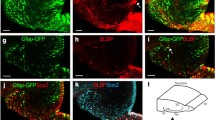Summary
Ten-day-old Sprague-Dawley rats were injected intraperitoneally with 3H-thymidine (3HTdR) and allowed to survive until postnatal day (P) 40, P120, P200, P300 or P450. Following the preparation of the tissue for autoradiography, the location of the labeled neurons within the granule cell layer of the dentate gyrus was determined at two different septo-temporal levels. At P40 the labeled cells in the suprapyramidal blade of the dentate gyrus were found only in the deep part of the granule cell layer, where it borders on the hilus, and more than four cell diameters from the molecular layer. The latter relationship remained constant at each of the five ages studied, but between P40 and P120 the average distance from the labeled granule cells to the hilus almost doubled. At the middle of the temporal portion of the dentate gyrus this trend continues with age, so that by P450 the labeled neurons, though no nearer to the molecular layer than at earlier stages, were found, on average, in the middle of the granule cell layer, more-or-less halfway between the hilus and the molecular layer. Near the middle of the septal half of the dentate gyrus a similar pattern was seen at P40 and P120 but thereafter the labeled cells within the granule cell layer remained at about the same distance from the hilus. These observations permit the following three conclusions: (i) there is a gradual accumulation of dentate granule cells throughout the life of Sprague-Dawley rats; (ii) the newly-generated cells are preferentially added to the deep aspect of the granule cell layer from which they progressively displace the earlier-formed cells; and (iii) there is no concomitant loss of a corresponding number of earlier-generated granule cells: in other words, there is no substantial “turnover” of granule cells in adult animals.
Similar content being viewed by others
References
Angevine JB (1965) Time of neuron origin in the hippocampal region. An autoradiographic study in the mouse. Exp Neurol, Suppl 2 13: 1–70
Barber PC, Raisman G (1978) Cell division in the vomeronasal organ of the adult mouse. Brain Res 141: 57–66
Bayer SA (1982) Changes in the total number of dentate granule cells in juvenile and adult rats: a correlated volumetric and 3H-thymidine autoradiographic study. Exp Brain Res 46: 315–323
Bayer SA, Altaian J (1974) Hippocampal development in the rat: cytogenesis and morphogenesis examined with autoradiography and low-level X-irradiation. J Comp Neurol 158: 55–80
Bayer SA, Yackel JW, Puri PS (1982) Neurons in the rat dentate gyrus granular layer substantially increase during juvenile and adult life. Science 216: 890–892
Boss BD, Peterson GM, Cowan WM (1985) On the number of neuronal cells in the dentate gyrus of the rat. Brain Res 338: 144–150
Cajal SRy (1893) Estructura del asta de Ammon. Anal Soc Esp Histol Natl Madrid 22: 53–114
Cotman CW, Nadler JV (1978) Reactive synaptogenesis in the hippocampus. In: Cotman CW (ed) Neuronal plasticity. Raven Press, New York, pp 227–271
Cowan WM (1973) Neuronal death as a regulative mechanism in the control of cell number in the nervous system. In: Rockstein M (ed) Development and aging in the nervous system. Academic Press, New York, pp 19–41
Cowan WM (1981) The development of the vertebrate central nervous system: an overview. In: Garrod DR, Feldman JD (eds) Development in the nervous system. Cambridge University Press, Cambridge (British Society for developmental biology symposium 5, pp 3–33)
Cowan WM, Fawcett JW, O'Leary DDM, Stanfield BB (1984) Regressive events in neurogenesis. Science 225: 1258–1265
Cowan WM, Gottlieb DI, Hendrickson AE, Price JL, Woolsey TA (1972) The autoradiographic demonstration of axonal connections in the central nervous system. Brain Res 37: 21–51
Cowan WM, Stanfield BB, Kishi K (1980) The development of the dentate gyms. Curr Topics Dev Biol 15: 103–157
Graziadei PPC, Monti Graziadei GA (1978) Continuous nerve cell renewel in the olfactory system. In: Jacobson M (ed) Handbook of sensory physiology, Vol 9. Springer, New York, pp 55–82
Guenéau G, Privat A, Drouet J, Court L (1982) Subgranular zone of the dentate gyrus of young rabbits as a secondary matrix. A high-resolution autoradiographic study. Dev Neurosci 5: 345–358
Hamburger V, Oppenheim RW (1982) Naturally occurring neuronal death in vertebrates. Neurosci Commun 1: 39–55
Janowsky JS, Finlay BL (1983) Cell degeneration in early development of the forebrain and cerebellum. Anat Embryol 167: 439–447
Kaplan MS, Bell DH (1983) Neuronal proliferation in the 9month-old rodent — radioautographic study of granule cells in the hippocampus. Exp Brain Res 52: 1–5
Kaplan MS, Bell DH (1984) Mitotic neuroblasts in the 9-day-old and 11-month-old rodent hippocamapus. J Neurosci 4: 1429–1441
Kaplan MS, Hinds JW (1977) Neurogenesis in the adult rat: electron-microscopic analysis of light radioautographs. Science 197: 1092–1094
Kaplan MS, McNelly NA, Hinds JW (1985) Population dynamics of adult-formed granule neurons of the rat olfactory bulb. J Comp Neurol 239: 117–125
Oppenheim RW (1981) Neuronal cell death and some related regressive phenomena during neurogenesis: a selectrive historical review and progress report. In: Cowan WM (ed) Studies in developmental neurobiology: essays in honor of Viktor Hamburger. Oxford University Press, New York, pp 74–133
Pearson HE, Payne BR, Cunningham TJ (1984) Regional variation in naturally occurring ganglion cell death paralled by microglial invasion in the postnatal cat retina. Soc Neurosci Abstr 10: 1080
Rakic P (1985) Limits of neurogenesis in primates. Science 227: 1054–1056
Schlessinger AR, Cowan WM, Gottlieb DI (1975) An autoradiographic study of the time of origin and the pattern of granule cell migration in the dentate gyrus of the rat. J Comp Neurol 159: 149–176
Stanfield BB, Cowan WM (1979) The development of the hippocampus and dentate gyrus in normal and reeler mice. J Comp Neurol 185: 423–460
Author information
Authors and Affiliations
Rights and permissions
About this article
Cite this article
Crespo, D., Stanfield, B.B. & Cowan, W.M. Evidence that late-generated granule cells do not simply replace earlier formed neurons in the rat dentate gyrus. Exp Brain Res 62, 541–548 (1986). https://doi.org/10.1007/BF00236032
Received:
Accepted:
Issue Date:
DOI: https://doi.org/10.1007/BF00236032




